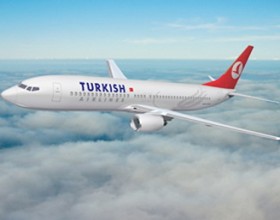 Turkish Airlines intends to double its frequency in Asia within the next two years, starting with Tokyo Narita, from four weekly flights to daily operations to Bangkok, which will include an equipment upgrade to 2 daily flights, 3 days a week in December 2009, with 4 flights extensions probably to Saigon, while the additional 3 flights are intended as flight extensions either to Manila or Guangzhou, depending on the services agreement that will be discussed later between the Philippines.
Turkish Airlines intends to double its frequency in Asia within the next two years, starting with Tokyo Narita, from four weekly flights to daily operations to Bangkok, which will include an equipment upgrade to 2 daily flights, 3 days a week in December 2009, with 4 flights extensions probably to Saigon, while the additional 3 flights are intended as flight extensions either to Manila or Guangzhou, depending on the services agreement that will be discussed later between the Philippines.
With today’s flight to Jakarta as an extension of the flights to Singapore, Turkish Airlines is stepping up it’s efforts to fly to more Asian destinations. This is an attempt to bolster load factors on that under-performing sector, especially by attracting Muslim religious traffic from Indonesia, which may wish to transit via Istanbul.
There are some bilateral trade discussions also under way, including a code sharing agreement between PT Garuda Indonesia and Turkish Airlines.
Turkish Airlines (THY) is lining up and waiting for the approval of the Air Service Agreement between Turkey and the Philippines this year, as it announces plans to introduce new destinations in the far east.
The airline is also planning to double the flights on its non-stop Bangkok-Istanbul route to 14 per week this December and introduce regular flights to Manila and Ho Chi Minh City, initially via Bangkok, in 2011.
Turkish Airlines is currently in discussions with Thai Airways International to establish a code-share agreement enabling the carriers to expand network coverage through Bangkok.
Turkish Airlines wants to build up Bangkok as a primary hub for Asia in a way that would develop the network capabilities of the Thai and THY, using their respective hubs in Bangkok and Istanbul to boost the joint market share with Thai on the Australia-Turkey route, among others. Ho Chi Minh City and Manila, as well as southern Chinese cities such as Guangzhou, are to be the target cities.
In the 12-month period from July 2008 to June this year, 56,987 passengers had flown between Australia and Turkey. Of the total, Singapore Airlines had a market share of 31 percent and Emirates 28 percent. The combined share of Turkish/THAI was a meager 3 percent.
Istanbul, a city at the legendary crossroads of the silkroad for Europe and Asia, is a natural transit point for travelers between Asia, Europe, Africa, the Americas, and now Asia-Pacific and Australia.
With Hong Kong declining to grant it an increase in capacity, the airline is planning to double its flights from daily to twice-daily to Bangkok in December. That huge capacity increase is a major reason why it needs to develop feeder traffic from across Asia-Pacific.
Since 2003, THY transit traffic has been the highest growth segment, up 230 percent from 470,200 passengers to 1,553,000 in 2008. The airline claims that in the same period, its annual passenger numbers have more than doubled from 10.4 million to 22.5 million, the number of destinations have grown from 104 to 155, and the number of aircraft have grown from 65 to 132.
In 2009, the target is 26.7 million passengers, including 14 million international passengers and more than 2 million transit passengers. New destinations expected by the end of this year include Ufa, Meshad, Dhakar, Nairobi, Sao Paulo, Benghazi, Goteborg, Lviv, Toronto, and Jakarta.
The airline, which is Europe’s fourth-biggest airline in terms of passengers carried, is expanding its fleet, especially long-haul, wide-body aircraft, and aims to increase its European market share by one-fifth to 10 percent next year. It is aggressively pursuing the transit passenger traffic by transforming Istanbul to become a major hub between Europe and Asia in competition with gulf-based carriers.
At present, Turkish Airlines serves points in Thailand, Singapore, South Korea, Hong Kong, Beijing, Shanghai, and lately Jakarta. It plans to resume service to Kuala Lumpur together with new services to China, the Philippines, and Vietnam. It also has plans to make Bangkok its Asian hub for flights to Australia by 2011.
Turkish currently flies to 119 international destinations, 18 in Asia, plus 36 cities in Turkey.
The delivery of 19 new aircraft, including seven Airbus A330s and seven Boeing B777s, worth more than US$2.5 billion, during 2011 to 2012, is central to the carrier’s international and Asian expansion.
It currently has a fleet of 132 aircraft, 49 of which are deployed on long-haul flights.
Turkish is on course to carry 26.7 million passengers this year, with plans to increase volume to 40 million by 2012.
The carrier is one of the global airline industry’s success stories.
While most other airlines face severe contractions, Turkish was recently ranked the fourth best-performing airline of the year by AviationWeek. It posted 9 percent growth in passenger traffic in the first half of this year, with distance flown rising by 17 percent and seat capacity up 28 percent.
The airline, listed on the Istanbul Stock Exchange, saw its passenger volumes rise steadily from 11.99 million in 2004 to 22.53 million in 2008.
Net profit soared from US$75 million in 2004 to US$204 million in 2007 before leaping to US$874 million last year.
The airline targets revenue of US$6 billion in 2011 and US$8 billion in 2012, spurred largely by the sharp increase in aircraft capacity.















